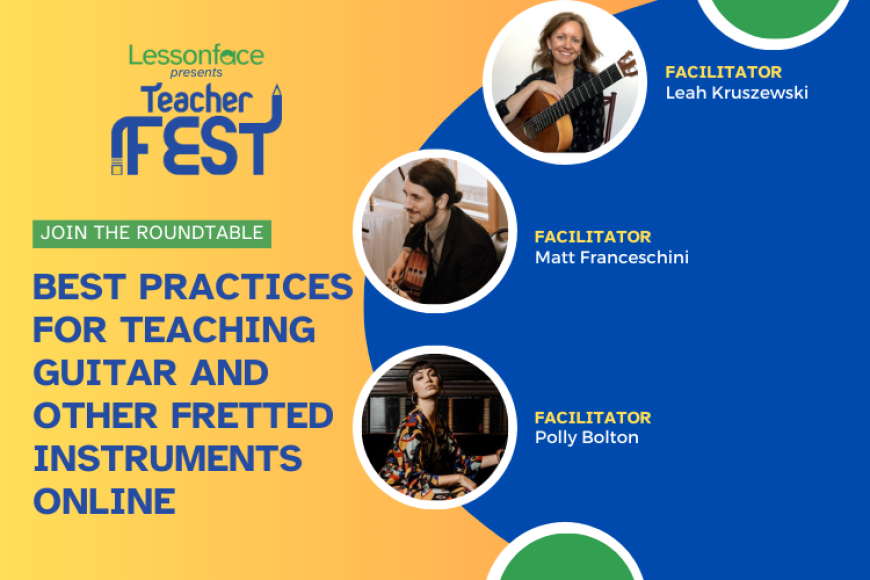Best Practices for Teaching Guitar and Other Fretted Instruments Online

Our TeacherFest webinar “Best Practices for Teaching Guitar and Other Fretted Instruments” was hosted by top Lessonface instructors Matt Franceschini, Polly Bolton, and Leah Kruszewski. Facilitators drew from their experience teaching a variety of fretted instruments: Matt teaches ukulele and nearly all styles of guitar (metal, rock, blues, jazz, and more); Polly specializes in mandolin, banjo, clawhammer banjo, and Irish bouzouki; Leah teaches classical, flamenco, and Loog guitar.
Here’s a recap of the information shared and topics discussed in the session.
Required technology, equipment, and environment to teach successful lessons
- Leah stresses the importance of a quiet environment. Background conversations, kitchen noises, etc. can be more distracting than you might think.
- The Original Sound setting in Zoom is a must. Without it Zoom cuts off frequencies and makes the guitar’s sound choppy or unintelligible.
- Leah uses an external webcam and USB mic. High-end sound equipment can be a plus if you already have it for recording or performing projects. If you don’t already own it, it may not be necessary as long as Original Sound is enabled.
- Headphones are nice for students who tend to be hard to hear.
- Polly’s teaching essentials include a USB mic, metronome, and notepad. She uses a Bose sound system as speakers, which she prefers over headphones.
- Polly prefers natural lighting whenever possible.
- Matt seconds the importance of Original Sound.
- He uses the internal mic on his MacBook Pro, which he’s found offers more than adequate sound quality. Leah also vouches for the quality of the Macbook’s internal mic, as she uses it when traveling.
- He also uses an inexpensive desk light placed in front of his computer for, as natural light is not an option in his workspace.
Optional extras for teaching online
- Leah uses few extras. One essential is a second screen, which she uses in order to keep students, music, and notes in view simultaneously. She uses built-in PDF software Preview, and uses Zoom’s screen share for viewing written music with students. She also uses Zoom’s recording feature to record videos for students during lessons, especially for flamenco lessons.
- Matt uses his iPad as a second screen for viewing and sharing music. That way he can keep the student in view on his laptop monitor.
- Leah agrees with the usefulness of an iPad, and uses it as her second screen when traveling.
- Polly uses Google Drive to share excel sheets with students, where she tracks progress and keeps tempo diaries. She uses Musescore to create customized worksheets for students.
- In response to a teacher’s question, Matt explains how he sets up his iPad as a second screen. You can do it wirelessly by AirPlay, and the iPad will appear as a second screen option in Zoom. Alternatively, you can plug the iPad into the Mac for optimal quality video during screen sharing.
Essential best practices for teaching successful online lessons
- Polly started teaching in person lessons and has taken care to adapt what works in person to teaching online.
- An openness and willingness to communicate are key. It’s important to keep things flowing, but also be ready to listen, take questions, and change the direction of the lesson if needed.
- Polly emphasizes the importance of enthusiasm, positivity, and encouragement in addition to honest feedback.
- Organization is key. She takes extensive notes immediately after the session to keep track of what we’ve done and tweak my plans for our next lesson. Notes and planning lessons take a lot of time and the work doesn’t end when the Zoom ends. If she teaches for 6-8 hours in a day she’ll usually spend an average of another 2+ hours on notes, recap videos and so on.
- Leah believes it’s important to be adaptable to many ability levels. It’s terrific to have gifted young students who could go on to be professionals if they choose. And it’s equally important to be positive and encouraging with students of lesser natural aptitude for music.
- She’s had some adult beginners who initially struggle with basic concepts, such as playing quarter notes with a metronome. When the student persists for several years and the teacher provides the right nurturing environment, they can improve immensely and achieve goals they never thought possible. The results are impressive and gratifying, for both student and teacher.
- For Matt, enthusiasm, kindness and patience are essential. He keeps in mind that everyone comes to music for different reasons and caters lessons to each student’s individual goals and desires to the best of my ability. What's best for one student is not what's best for another. Whenever possible he tries to relate technical exercises to material being covered so that the connection is as tangible as possible.
Essential technology and equipment, and nice-to-have extras for students
- Leah tries to not request extra equipment unless absolutely necessary. Original sound, on the other hand, is crucial.
- Matt finds that the majority of his students don’t need any extra equipment or adjustments beyond what they already have. His students play electric guitar, and the sound set-up with an amp seems to work well with built-in mics and speakers.
- When students use an iPad for lessons, Polly strongly recommends an iPad stand. Propping iPads up on books or other items usually leads to it moving or tipping in the lesson, which is distracting. A stand keeps the device still and at the right angle.
- Polly and attending student Jeffery Gee mention that it’s important for students to have an external speaker if they’ll be playing along with a backing track during lessons.
Communication tips to to establish a successful long-term routine
- Polly tries to establish a great rapport early on and get a good understanding of the student’s musical tastes and goals for music lessons. She asks her students why they want to play, where they want to go with it, and who they admire and aspire to be.
- Matt says that having a flexible scheduling policy is helpful, as his schedule changes frequently. He’ll always give at least 24 hours notice, and does his best to be equally flexible with his students when they have schedule changes come up.
- Matt also invites his students to email him whenever they are struggling with something between lessons, and replies within 24 hours.
- A teacher asked for tips on making post-lesson videos for students.
- Polly records exercises with the instrument and metronome visible on camera. She always uses a metronome and counts in on videos, so students can play along.
- Leah makes most of her recordings during lessons. She mutes the students’ side and has them play along if possible. Sometimes she’ll move her external camera to show a hand angle better.
- Matt talks through the important points of the piece or exercise, and prefers to send the video as an unlisted Youtube link. That way he can even see how many times a student watched the video.
Challenges encountered as a teacher and how to manage them
- Polly teaches two visually-impaired students and finds it challenging and rewarding. Because she teaches by ear, they are able to learn very well over Zoom. They use special software to convert sheet music (sent after the lesson) to a format that they can use.
- Another challenge for her and many Lessonface teachers is travel for tours and performances. Her students are all very understanding and often ask her to help out with performance-specific matters such performance anxiety, stage presence, general stagecraft, equipment, and other elements of being a touring musician. She finds it helpful to have first hand experience to share with her students.
- She adds that it’s always nice when students can come to her shows. She’s connected with students all over the world in real life at her shows and it’s magical.
- For Matt, one common challenge is internet connection issues on the student’s end. He tries to be flexible and add time to the session if possible, and maintains a positive vibe even if students get frustrated with the issue.
- Occasionally, adult students get frustrated when they feel they are progressing too slowly. He tries to talk it out with the student and see how they’re feeling and how they’re using their practice time. That enables him to empathize with how they’re feeling and craft a plan that they can use to get themselves out of the rut and make progress. Matt always tries to keep encounters with students as uplifting and inspirational as possible.
- A teacher asks about tips for student recruitment at Lessonface.
- Leah recommends taking the first steps to invite your own students to take lessons on the platform. That way you can generate the initial reviews and credibility you need to attract students on the site.
- Check out this article for more information on finding students.
Thank you to our three excellent facilitators and for all teachers who attended the webinar!
Montreal-based guitarist Matt Franceschini has been playing and performing for more than a decade in genres ranging from Death Metal to Modern Jazz. Matt aims to foster a love and passion for music within his students by customizing each student's lessons curriculum to match their musical tastes and goals. Whether the student is a 5-year-old or a 65-year-old, Matt aims to get them playing the music that they love from the very first lesson.
Based in London, Polly Bolton tours internationally in various line ups on mandolin, Irish bouzouki, 5-string banjo and vocals since her teens. She has an innovative approach to writing and arranging and is influenced by a wide range of musical styles and instruments from across the globe. Polly is in high demand as a music instructor and tailors lessons to suit individual requirements and interests.
Leah Kruszewski lives in Seville, Spain, where she plays flamenco guitar with singers and dancers and teaches the art form to visitors from all over the world. Leah loves introducing guitarists to the rhythms and melodies of southern Spain and guiding classical players as they develop their technique and repertoire. She also enjoys teaching young beginners in Loog and acoustic guitar.




